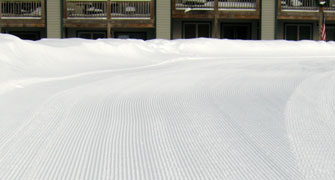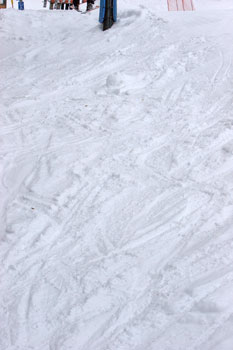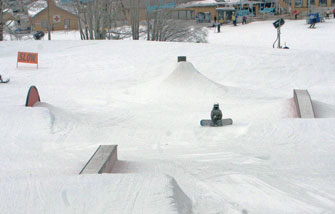Ski Buying Guide
Choosing the right ski is important, if you are going to ski to the best of your ability!!!
Buying a pair of skis is one of the most important ski-related decisions you can make. Having a ski that is designed for the type of terrain on which you ski and matched specifically to your ability level will greatly influence how well you ski and how much fun you have. In this article, we will provide a few simple rules to help you in selecting the right ski.
Two most important things to consider when buying skis
To simplify the ski buying process somewhat, the two main factors to consider are: 1) what is your ability level? and 2) where do you prefer to ski? Once you have determined the answers to these questions, you simply match your responses to the appropriate ski category.
1 - What is your skiing ability level?
Use the guide below to determine your skiing ability level. If you are honest with yourself, your skiing will improve more quickly and you will have a better time on the slopes.
- Beginner: People who have never skied before, or have only done so once or twice in the past, fall under this category.
- Intermediate: This category is used to define people who are comfortable on intermediate runs, but are not interested in going on expert black diamond runs or testing how fast they can go. If you only go skiing when you’re dragged out on family vacations, and prefer to stay on safe and easy runs, this category describes your ability level.
- Advanced: If you are not an expert, but ski frequently, don’t mind fast speeds, aggressively attack the hill, like to try different types of terrain, and/or you're athletic, this is the category for your ability level. If you are striving to become an expert, a ski made for this ability level will get you there faster than an expert-level ski.
- Expert: If you can ski well anywhere on a mountain (including through bumps, powder, ice, and crud), you are defined as an expert-level skier.
2 - What type of terrain do you ski?

Figure 1 - Groomed Terrain
Different skis are designed for different types of terrain. For example, a ski that is designed to go fast on ice (i.e., race ski), will be hard, if not impossible, to ski in deep powder. As a general rule, you should buy a ski made for the area where you ski the most. In New England, you would want a stiffer ski for the hard packed snow typical to that area. In Utah, you would want a softer ski for the softer snow. Be aware, it is a common mistake to buy a ski for the type of snow you would like to be skiing (e.g., powder) vs. the type of snow actually found at your local ski area. Below, we list various types of terrain commonly found at a ski resort.

Figure 2 - Non-Groomed Terrain
- Groomed runs: Groomed runs, commonly referred to as piste, are smooth, soft, and easy to maneuver. They contain no bumps, ice, or crud, hence making them ideal for clean, sharp, carved turns. See Figure 1 - Groomed Terrain.
- Mixed terrain: Select mixed terrain if you ski a combination of groomed runs, crud, bumps, powder, and ice.
- Non-groomed runs: Select non-groomed runs if you primarily ski hard-core powder, bumps, ice, and crud, with very little time on groomed slopes. See Figure 2 - Non-Groomed Terrain for an example of non-groomed terrain.
- Terrain Parks: This includes terrain park rails, half pipes, and big air. See Figure 3 - Terrain Park.
- Powder: This is for powder only.
- Race: This is for an iced-down racecourse. Nastar racers need not apply, because you do not go fast enough in a Nastar course to make these skis turn easily.

Figure 3 - Terrain Park
What type of ski should you select?
The ski categories listed below will help you determine what type of ski you want. When you look at a specific manufacturer’s skis, you will notice that although they offer skis in each category, there is typically a lot of overlap between the different categories. In general, the wider the ski is under your foot, the better it will perform in terrain with crud and powder. The narrower the ski, the better it will perform quick, fast turns on groomed slopes. The stiffer the ski, the more stable it will be at higher speeds, but the harder it will be to turn at slower speeds.
- Beginner skis: In general, we do not recommend buying a pair of beginner skis. You should rent skis when you first get started. After you become an intermediate skier, then buy a pair of intermediate-level skis.
- Intermediate skis: You should buy a pair of intermediate-level skis if you are happy staying on gentle groomed slopes, are not interested in going fast, and don't ski very often. A new skier trying to advance as fast as possible will find that doing so is easier and faster on an intermediate-level ski.
- Advanced and expert skis: Advanced and Expert skis are very similar with one exception, stiffness. To determine which skis to get you have to ask yourself, how fast do you want to go? The stiffer the ski, the more stable it is at high speeds, but it is harder to turn at slower speeds. There are three subcategories you will need to consider and each one comes in various levels of stiffness designed for how fast you would like to go.
- Skis designed for groomed runs: These are typically designed for cruising or carving. They are narrower under foot than the others, which make them respond faster and quicker in turns. The downside to these types of skis is that they will be too responsive or twitchy on non-groomed surfaces.
- Skis designed for a mixed terrain: In general this is the most versatile ski you can buy. It will carve on the groomers and it will let you jump into powder, bumps, crud, and ice.
- Skis designed for non-groomed runs: These skis are wider than cruisers and carvers to keep you on top of powder and crud. They are very stable in non-groomed conditions, but will never carve like a ski designed for carving on groomed slopes.
- Race skis: Race skis are made for iced-down racecourses. In general we do not recommend these skis to the average skier. They are too stiff for Nastar courses and do not perform well at slow speeds or on non-groomed conditions. You will notice that very few retailers stock race skis, for the reasons noted above.
- Powder skis: If you mainly ski deep powder, this category of ski will make powder skiing easier than any of the other ski models.
- Terrain park skis: These skis are made for terrain park rails, pipes, and big air. The twin tips let you land backwards. Some terrain park skis have metal bars built into the base, specifically for riding rails.
- Woman specific skis: We highly recommend woman's skis. Ski manufacturers have come a long way in designing skis that consider a woman's lower center of gravity and slightly wider hips.
Demo Skis Before You Buy
Go to a Ski Demo Days. Demo days provide an amazing wealth of information. Multiple snow sports companies, including ski, snowboard, goggle, sunglass, helmet, and clothing manufacturers, usually attend these events. Knowledgeable reps man these shows and like to talk shop with customers. They will steer you toward the gear best fitted to your needs. A little due diligence is all it takes to find a demo day in your area - many demo days are posted on ski resort websites, and often the manufacturers themselves can direct you to where and when a demo day is taking place. Spend your time wisely. Use the same run to test so you get a consistent comparison of the different types, sizes, and brands of skis.
Demo skis from your local ski shop. Renting a pair of skis is a good way to try the ski before you buy. Talk to your local ski shop about testing a pair of skis - many of them have high-end ski rentals.
After you find that perfect match, then you can shop around to ensure that you get the best price.
